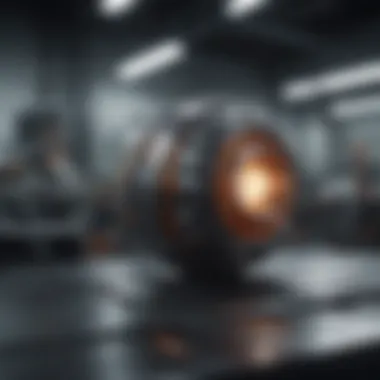Exploring WPI Rapid Prototyping: Methodologies and Innovations


Intro
Rapid prototyping has emerged as a pivotal area of focus within engineering disciplines, reflecting a need for accelerated design and production processes. Worcester Polytechnic Institute (WPI) stands at the forefront of this revolution, employing a robust framework to explore various methodologies, applications, and innovations in rapid prototyping. The convergence of educational practices and research in this domain not only facilitates the advancement of engineering principles but also equips students and professionals with the necessary skills for tomorrow's challenges.
In the following sections, we will dissect essential concepts related to rapid prototyping, examine notable advancements, and scrutinize the collaborative efforts between academia and industry. This detailed exploration provides valuable insights into the effectiveness of WPI's approach while probing into the future landscape of rapid prototyping.
Key Concepts
Definition of Primary Terms
Rapid prototyping refers to a set of techniques utilized to quickly fabricate a scale model or a functional prototype of a part or assembly using 3D computer-aided design (CAD) data. This process allows designers and engineers to visualize and test ideas rapidly. Key terms related to this process include:
- Additive Manufacturing: A production method that builds objects layer by layer from materials such as plastic, metal, or resin.
- 3D Printing: A type of additive manufacturing where three-dimensional digital models are printed to produce tangible objects.
- CAD: Computer-aided design software used to create precise drawings and models of physical components.
Related Concepts and Theories
Understanding rapid prototyping also necessitates familiarity with related concepts such as design thinking and iterative development. Design thinking places emphasis on user-centered design, fostering innovation through empathy and collaborative processes. Iterative development allows for repeated cycles of prototyping, testing, and refining, enhancing product quality and functionality.
Methodologies in Rapid Prototyping
WPI employs diverse methodologies within their rapid prototyping framework. The integration of multiple approaches ensures that students and researchers can leverage the most effective strategies based on project requirements. Techniques such as laser cutting, CNC machining, and various 3D printing technologies are typically incorporated. Each of these methodologies has unique advantages and specific applications depending on the material and desired outcome.
Applications and Innovations
The applications of rapid prototyping span numerous fields including aerospace, automotive, healthcare, and consumer products. Innovations emerging from WPI have led to significant advancements like improved material properties in 3D printed objects and the development of automated processes that reduce time and waste. The collaboration between different departments and industry partners propels this innovation forward, resulting in practical solutions that tackle real-world problems without delay.
Future Directions
Gaps Identified in Current Research
Despite the progress, certain gaps exist in current research. For instance, while material diversity has improved, the exploration of bio-compatible materials remains limited. Furthermore, sustainable practices in rapid prototyping warrant deeper investigation to understand environmental impacts effectively.
Suggestions for Further Studies
Future studies could examine the integration of artificial intelligence in the design and testing phases to automate decision-making. Additionally, research focusing on the impacts of new materials on product performance would be beneficial. Engaging in interdisciplinary research can often yield unexpected insights, potentially transforming existing methodologies.
"Innovation is the key to unlocking the future of design in engineering."
As rapid prototyping continues to evolve, WPI's contributions emphasize the importance of blending educational objectives with practical applications. This holistic approach not only prepares students to enter the workforce but also facilitates ongoing innovations that influence various industries.
Prelims to Rapid Prototyping
Rapid prototyping is an essential process in the realm of engineering and design that allows for swift development of products, systems, and solutions. This method significantly reduces the time taken from ideation to production, making it critical in today's fast-paced technological environment. By creating tangible models or functional prototypes quickly, designers and engineers can test concepts, evaluate functionality, and make iterative adjustments efficiently. This approach not only minimizes resource expenditure but also enhances collaboration among stakeholders during the development cycle.
In this article, we will explore the methodologies employed in rapid prototyping, the tools and technologies that facilitate these processes, and the unique applications observed at Worcester Polytechnic Institute (WPI). The importance of understanding these elements lies in their ability to drive innovation and foster educational advancement in engineering.
Definition and Importance
Rapid prototyping refers to a category of techniques used to produce scale models of a physical part or assembly using three-dimensional computer-aided design (CAD) data. This process may involve various methods such as additive manufacturing, CNC machining, and other technologies that support quick production. The significance of rapid prototyping cannot be overstated. It has transformed how products are developed by enabling faster iterations, reducing development risks, and allowing for more creative exploration of design options.
By utilizing rapid prototyping techniques, individuals and organizations can attain the following benefits:
- Increased Speed: Rapid prototyping accelerates the development cycle, allowing for quicker feedback and iteration.
- Cost Efficiency: It reduces costs associated with traditional prototyping methods by minimizing material waste and production time.
- Enhanced Creativity: Designers can experiment with different ideas without extensive material investment.
- Improved Communication: Prototypes provide a visual and tactile representation of concepts, aiding discussions among team members and stakeholders.
Historical Context
The origins of rapid prototyping can be traced back to the late 20th century, with the advent of technologies such as stereolithography, which was invented by Chuck Hull in 1986. This innovative method allowed users to convert digital models into physical objects layer by layer. Initially, rapid prototyping technologies were limited and expensive, accessible mostly to large corporations.
Throughout the 1990s and early 2000s, advancements in 3D printing, laser cutting, and other methods began to democratize rapid prototyping. Smaller companies and academic institutions started to adopt these technologies, paving the way for widespread usage across various sectors. Eventually, the integration of affordable desktop 3D printers further expanded access to rapid prototyping tools, enabling even hobbyists and individual practitioners to bring their ideas to life.
Today, rapid prototyping sits at the crossroads of engineering, medicine, and art, impacting numerous industries by enabling innovative product design, testing, and validation. As we venture further into this exploration of WPI's methodologies, applications, and innovations in rapid prototyping, a deeper understanding of its foundational elements will become clear.


WPI's Approach to Rapid Prototyping
Worcester Polytechnic Institute (WPI) has developed a distinctive approach to rapid prototyping, emphasizing both innovation and education. This focus is crucial as it blends theoretical knowledge with practical application, creating a robust learning environment for students. The methodologies adopted at WPI help students grasp the significance of rapid prototyping in engineering, allowing for improved design processes and faster product development.
Curriculum Integration
The integration of rapid prototyping within WPI's curriculum reflects its commitment to practical experience in engineering. Students engage with various tools and technologies from their first year of study, which allows them to experience the rapid iterative design process firsthand. This method not only aids in developing technical skills but also promotes critical thinking.
WPI offers courses that specifically teach methodologies like 3D printing and CNC machining, offering students a comprehensive understanding of their applications. Moreover, project-based learning is emphasized, wherein students are tasked with real-world problems that require rapid prototyping solutions. This can lead to a deeper understanding of how theoretical concepts translate to practical outcomes.
Key benefits of this approach include:
- Skill acquisition: Students learn to use advanced prototyping tools effectively.
- Hands-on experience: Real projects enhance learning and retention of information.
- Interdisciplinary collaboration: Students from different engineering disciplines can work together, fostering teamwork and communication.
Research Facilities
WPI's research facilities support its rapid prototyping mission. These facilities are equipped with state-of-the-art technologies that encourage innovation. For example, the Advanced Prototyping Lab is a hub for experimentation, allowing students and researchers to test and refine their designs.
Moreover, space for collaboration and brainstorming is vital. WPI fosters an environment where ideas can evolve into prototypes, leading to practical solutions in engineering. Facilities are staffed by experienced mentors who guide students through complex processes.
Research initiatives often invite industry partnerships, further strengthening the relationship between academia and practical application. This access to industry-grade tools and resources helps students produce prototypes that are not just theoretically sound but viable in real-world scenarios.
In summary, WPI’s approach to rapid prototyping is comprehensive. Curriculum integration and advanced research facilities work in tandem, equipping future engineers with necessary skills and resources. This framework is essential in preparing students for the challenges they will face in their careers, thus enhancing the relevance of rapid prototyping in today’s fast-paced engineering landscape.
Technologies in Rapid Prototyping
In the realm of rapid prototyping, technology serves as a cornerstone, shaping the methodologies and applications that dominate this field. The evolution of various technologies has led to enhanced speed, precision, and versatility in creating prototypes. As industries continue to demand faster product development cycles, the significance of these technologies cannot be overstated. Understanding the different technologies employed in rapid prototyping sheds light on the advantages and constraints that engineers and designers face throughout their processes.
3D Printing Techniques
3D printing has revolutionized rapid prototyping by enabling the transformation of digital models into physical objects swiftly and efficiently. This technique stands out for its ability to handle complex geometries that traditional manufacturing methods often struggle with. One of the prominent methods of 3D printing is Fused Deposition Modeling (FDM). This process involves a thermoplastic filament being heated and extruded layer by layer to form an object.
Additionally, Stereolithography (SLA) offers high detail and smooth surface finishes by curing liquid resin with a UV laser. On the other hand, Selective Laser Sintering (SLS) allows the use of powder materials, which can create durable prototypes without the need for support structures. Importantly, each technique has its specific materials and applications, and selecting the right one depends on the project requirements. For example, FDM is often preferred for functional testing due to its cost-effectiveness, while SLA is suitable for intricate designs.
These 3D printing methods contribute significantly to reducing lead times and costs in prototyping stages. They enable multiple iterations and rapid adjustments based on feedback, which is crucial for innovation.
CNC Machining
CNC Machining, or Computer Numerical Control Machining, is another fundamental technology in rapid prototyping. This method employs computer-controlled machines to cut, shape, and fabricate parts from a block of material. CNC machining is known for its precision and ability to work with various materials, including metals, plastics, and composites.
One of the key advantages of CNC machining is its scalability. It can produce both low and high volumes of parts with consistent quality. This technology is particularly valuable in engineering where exact specifications are critical. Components fabricated using CNC machining can be used for functional testing, and their durability often surpasses that of 3D printed counterparts. However, it is also important to consider that CNC machining can have higher setup costs and longer lead times compared to additive manufacturing methods.
Laser Cutting and Engraving
Laser cutting and engraving provide a highly efficient method for rapid prototyping by utilizing focused laser beams to cut or engrave materials with high precision. This technology is particularly advantageous due to its ability to work with a variety of substrates, including wood, acrylic, metal, and textiles.
The advantages of laser cutting include not only speed but also minimal material waste, as the laser cuts with a narrow kerf. This efficiency is critical for both prototyping and production environments where material costs are a concern. Moreover, laser engraving allows for detailed designs and markings, making it ideal for custom products and prototypes that require intricate details.
Applications of Rapid Prototyping
The significance of rapid prototyping spans across various industries. By allowing designers and engineers to create models quickly, it reduces the time from concept to production. In this section, we will explore several key applications of rapid prototyping, each contributing to innovation, efficiency, and enhanced collaboration.
Engineering and Product Design
In engineering and product design, rapid prototyping serves as an invaluable tool. It facilitates the transformation of abstract ideas into tangible prototypes. This allows for functional testing and user feedback at early stages, minimizing costly changes during full-scale production. Designers can iterate quickly, refining their products based on real-world data. For instance, a company can develop a prototype prototype of a new electronic device, test it, and revise its design within days rather than weeks.
Additionally, rapid prototyping enhances creativity. Engineers are inspired to explore unconventional ideas without the fear of significant investment. With tools like 3D printing, complex geometries become viable, leading to innovative solutions that were once too expensive or impractical.
Medical Device Development
The medical field benefits profoundly from rapid prototyping. It enables the creation of customized medical devices tailored to individual patient needs. For example, prosthetics can be designed to fit perfectly to the user, improving comfort and functionality. Rapid prototyping allows for the testing of these devices in actual use settings, leading to better outcomes.


Moreover, developing surgical tools requires precision and testing. Models constructed via rapid prototyping allow surgeons to practice or visualize complex procedures. The impact of this application directly correlates to improved patient safety, as training becomes more effective and accessible.
"Rapid prototyping in healthcare leads to innovations that can save lives."
Architectural Models
In architecture, rapid prototyping aids in visualizing and evaluating design concepts. Physical models provide insights into spatial relationships and aesthetics that are hard to capture through digital means alone. Architects can present ideas more effectively to clients and stakeholders, which is crucial for gaining approvals.
Creating architectural models through techniques like laser cutting or 3D printing allows for intricate designs to be showcased. It makes the design process more collaborative, as clients can provide immediate feedback on physical representations. This direct engagement helps align the final designs with client expectations.
In summary, rapid prototyping transforms how prototypes are created and assessed across fields. Engineering and product design benefit from its speed and innovation potential, while medical device development focuses on customization and patient safety. The architectural models stand as physical representations that facilitate better communication and collaboration in design.
Collaborative Projects at WPI
Collaborative projects are crucial in understanding the practical applications and innovations in rapid prototyping at Worcester Polytechnic Institute. The merging of academic knowledge with real-world demands creates an environment conducive to both learning and development. This section explores two primary avenues through which WPI engages in collaborative projects: industry partnerships and student-led initiatives.
Industry Partnerships
WPI has established strong connections with various industries. These partnerships provide students and faculty access to resources and insights that would otherwise be unattainable. Organizations such as Raytheon Technologies and General Electric often collaborate with WPI, leading to the development of prototypes that address industry-specific challenges. These relationships enable rapid prototyping projects to tackle real-world problems, enhancing relevance and applicability.
Benefits of these industry partnerships include:
- Access to Funding: Many industry partners contribute financial resources to ensure the success of collaborative projects.
- Mentorship Opportunities: Industry professionals often mentor students, providing invaluable guidance throughout the prototyping process.
- Career Pathways: Students gain exposure to potential employment opportunities through their interactions with corporate partners.
The projects often focus on creating prototypes that meet stringent industry standards, ensuring students apply theoretical principles in practical settings. This prepares them for future roles in design, engineering, and project management.
"The collaboration between WPI and industry is a symbiotic relationship that cultivates innovation."
Student-Led Initiatives
Student-led initiatives at WPI play a significant role in promoting rapid prototyping. These initiatives empower students to take charge of their learning and apply theoretical concepts to real-world scenarios. Projects range from developing sustainable products to designing healthcare devices, allowing students to address various societal needs.
Key aspects of student-led initiatives include:
- Creativity and Innovation: Students have the freedom to explore their ideas. This aspect often leads to innovative solutions that may not emerge in traditional projects.
- Teamwork and Leadership: Working in teams cultivates essential soft skills such as communication, teamwork, and leadership.
- Portfolio Development: Students can showcase their projects, adding tangible experience to their resumes and portfolios.
These initiatives are often showcased through exhibitions and competitions, allowing students to gain recognition for their work. The success of these projects demonstrates WPI's commitment to fostering an environment where students can experiment, learn, and innovate.
In summary, collaborative projects at WPI, whether through industry partnerships or student-led initiatives, are vital to advancing rapid prototyping methodologies. These projects not only enrich the educational experience but also contribute significantly to relevant technological advancements.
Challenges in Rapid Prototyping
Rapid prototyping, despite its many advantages, presents a range of challenges that can hinder its implementation and effectiveness. Understanding these challenges is essential for both practitioners and educators involved in engineering and design. This section delves into the crucial difficulties faced in rapid prototyping, focusing on material limitations and cost considerations.
Material Limitations
The success of rapid prototyping largely depends on the materials used in the prototyping process. Various materials each have distinctive properties that might not align with the demands of a specific project. For instance, some materials may exhibit poor durability, while others may lack the necessary flexibility. This limitation creates hurdles in producing prototypes that faithfully represent the final product’s performance.
Moreover, the availability of materials can be restrictive. Not all materials suitable for emerging technologies are readily accessible. For example, advanced polymers and composites often require specialized suppliers. As a result, designers may face delays or be forced to compromise on their designs, reducing overall innovation. In addition, the environmental impact of certain materials is becoming increasingly relevant, prompting calls for more sustainable options.
"A prototype is only as good as the materials used to create it, and limitations can lead to misinterpretation of the final product's capabilities."
Cost Considerations
Financial aspects of rapid prototyping are also a significant challenge. The costs associated with high-quality prototyping can be substantial. The equipment used, such as advanced 3D printers or CNC machines, can require significant capital investment. Ongoing maintenance and operational costs further add to the financial burden.
Furthermore, the cost of materials can fluctuate based on market dynamics. Certain high-performance materials can be prohibitively expensive, particularly for startups or small-scale projects. This can lead to suboptimal choices that may impact the design and functionality of the prototype. Organizations must carefully balance their budget against the need for quality and innovation.
In summary, navigating the challenges of material limitations and costs is paramount to successfully leveraging rapid prototyping technologies. As WPI continues to emphasize these fields, strategies must be formulated to address these issues effectively, hence fostering a more innovative and sustainable approach to rapid prototyping.
Educational Impact of Rapid Prototyping


The educational impact of rapid prototyping is multifaceted. It plays a critical role in shaping how students and professionals engage with engineering concepts. The methodologies utilized in rapid prototyping offer hands-on experience that is vital for fostering deeper comprehension and practical skills. Furthermore, the integration of these practices within the education system enriches the overall learning environment.
Rapid prototyping is not simply an auxiliary tool; it has become central to pedagogical frameworks at institutions like Worcester Polytechnic Institute. By engaging with real-world applications, students grasp theoretical knowledge more effectively. The significance lies not only in individual skill acquisition but also in the development of crucial problem-solving and collaborative abilities.
Skill Development
Skill development is a core outcome of engaging with rapid prototyping techniques. Students learn to operate advanced machines and software, gaining experience in both manual and digital fabrication. This practical training develops technical proficiency that is highly sought after in job markets.
Some key skills fostered through rapid prototyping include:
- 3D modeling and design: Students understand how to create digital representations of their ideas before physical implementation.
- Material selection: Knowledge of materials allows students to choose appropriate substances for various applications, impacting durability and functionality.
- Critical thinking: The iterative nature of prototyping encourages students to refine their ideas and evaluate their designs continuously.
As students pursue projects, their understanding of design processes evolves. They learn to iterate on feedback, which enhances their ability to critique and improve upon their own work. Such skills are essential in any engineering discipline.
Interdisciplinary Collaboration
Interdisciplinary collaboration is another vital element encouraged by rapid prototyping. Students from diverse fields such as engineering, art, and computer science come together to tackle complex problems. This collaboration enriches perspectives and fosters innovative solutions.
Working alongside peers from various disciplines teaches students to:
- Appreciate different viewpoints and methodologies in problem-solving.
- Communicate effectively across technical and non-technical domains.
- Leverage collective strengths when developing prototypes, leading to more robust final products.
Such projects often result in richer learning experiences. The diversity of skill sets leads to creative outcomes that might not have emerged in more siloed environments. Ultimately, rapid prototyping not only cultivates individual skills but also nurtures a culture of collaboration and innovation that is crucial for future advancements in technology.
Future Trends in Rapid Prototyping
The evolution of rapid prototyping has reached a pivotal moment where technological advancements intersect with innovative methodologies. As industries strive for greater efficiency and effectiveness, the future of rapid prototyping becomes a focal point for research, education, and application. It holds immense potential not only for producing prototypes faster but also for enhancing their quality and functionality. The exploration of future trends will reveal how WPI is preparing its students and researchers to tackle the challenges and opportunities that lie ahead in this field.
Integration of AI and Automation
Artificial Intelligence (AI) is set to revolutionize the landscape of rapid prototyping. By incorporating machine learning algorithms, processes can be optimized for both speed and accuracy. Automated systems can analyze data from previous prototypes to predict failures and suggest modifications before actual production begins. This integration significantly reduces trial and error, resulting in lower material waste and reduced costs.
Furthermore, AI can facilitate a more personalized approach to design, enabling tailored solutions for specific user needs. For instance, generative design software uses algorithms to explore various design alternatives based on defined parameters. This leads to innovative and efficient product designs that conventional methods might overlook.
The potential for automation in rapid prototyping extends beyond design. Robotics can automate assembly and finishing processes, freeing human resources for more complex tasks that require critical thinking and creativity. These advancements enhance productivity and allow for simultaneous processes that speed up project timelines.
Sustainable Practices
Sustainability has become a pressing issue across all sectors, including rapid prototyping. The integration of sustainable practices in this field is not only beneficial for the environment but also enhances the overall value proposition of products. The focus on materials that are recyclable or derived from bio-based sources is increasing. For instance, using recycled plastics or eco-friendly resins in 3D printing can significantly reduce the carbon footprint of prototypes.
Additionally, the concept of minimizing waste during the prototyping process cannot be overstated. Techniques such as subtractive manufacturing, where excess materials are removed rather than added, are increasingly being refined to ensure that resources are efficiently utilized. This is vital for both environmental impact and cost reduction.
The promotion of a circular economy is another trend gaining traction. Encouraging the reuse of materials and implementing take-back schemes can significantly mitigate waste in rapid prototyping. Educational institutions like WPI are leading the charge by instilling these values in students, preparing them to be responsible practitioners in their respective fields.
In summary, as rapid prototyping continues to adapt to the demands of modern industries, the trends of integrating AI and emphasizing sustainability will play crucial roles. These advancements not only prepare professionals for the future but also ensure that the evolution of rapid prototyping aligns with global priorities.
The End
The conclusion serves as a critical synthesis of the entire discussion surrounding rapid prototyping at Worcester Polytechnic Institute (WPI). It encapsulates the core ideas while also reflecting the broader implications of the methodologies, applications, and innovations highlighted throughout the article. By reiterating key points, such as the effectiveness of WPI's educational framework and its contribution to various industries, the conclusion helps to solidify the reader's understanding of this topic.
It becomes clear that the integration of rapid prototyping into engineering education and practice unlocks significant benefits. These include faster product development cycles, enhanced collaboration among interdisciplinary teams, and the potential for creative solutions that can address complex challenges.
This section also allows for the placement of considerations about potential future developments in rapid prototyping, emphasizing that innovation is an ongoing process. As technology progresses, WPI's role in shaping these advancements will remain vital. Therefore, the conclusion emphasizes that continuous learning and adaptation within the field are essential for stakeholders.
Recapitulation of Key Insights
In reviewing the key insights derived from this article, several points warrant emphasis. Rapid prototyping is more than just a technological tool; it embodies a methodological approach that fosters creativity and efficiency in design. WPI's curriculum effectively integrates hands-on experience, ensuring that students grasp both theoretical and practical aspects of rapid prototyping.
Noteworthy applications across diverse sectors, such as engineering and medical fields, showcase the versatility of rapid prototyping. The relationship between academia and industry, nurtured through collaborative projects, facilitates the real-world application of innovations.
Furthermore, challenges, such as material limitations and costs, remain pertinent, but they also present opportunities for future advancements. The discussion around sustainable practices and the advent of AI in rapid prototyping opens avenues for further exploration and innovation.
Call for Further Research
The exploration of rapid prototyping at WPI indicates substantial merit in further academic inquiry. There are numerous avenues for research that would enrich the existing body of knowledge. These include investigating new materials that can be employed in rapid prototyping processes, studying the impact of artificial intelligence on design efficiency, and analyzing the long-term implications of rapid prototyping in product lifecycle management.
Additionally, interdisciplinary collaboration should be prioritized in research settings. Encouraging partnerships between engineering, healthcare, and design disciplines can lead to breakthroughs that address complex societal issues. The evolving landscape of technology means that ongoing research is vital to remain at the forefront of innovation.



